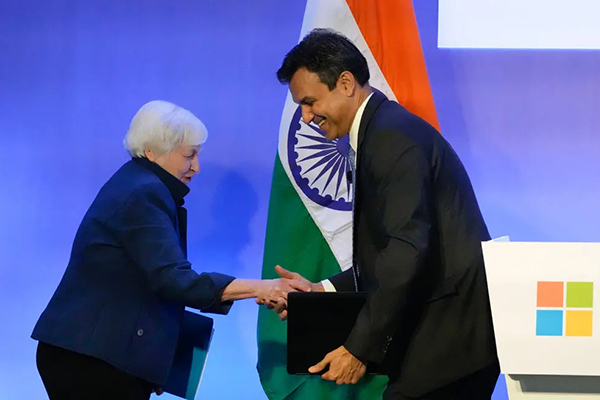
The United States is placing India at the center of its ambition to detach global supply chains from the clutches of US adversaries, seeking to cement ties with one of the world’s fastest-growing economies as tensions with China remain high and as Russia’s war in Ukraine upends international commerce.
US Treasury Secretary Janet Yellen, the Biden administration’s top economic diplomat, delivered that message in person on 11 November during a visit to the Indian capital at a moment of intense global economic uncertainty. Soaring food and energy prices stemming from Russia’s war and heightened concerns about America’s reliance on Chinese products have pushed the United States to try to reshape the global economic order so that allies depend on one another for the goods and services that power their economies.
India is often in the middle of geopolitical jostling between the United States, China and Russia. But as the Biden administration promotes what it calls “friend-shoring,” it is making clear that it wants India to be in America’s orbit of economic allies.
After a tour of Microsoft’s research and development campus on the outskirts of New Delhi on Friday, Yellen outlined the case for shifting away from nations that could destabilise America’s supply chains and from manufacturers that show little regard for human life. It was evident that China and Russia were top of mind.
“The United States is pursuing an approach called ‘friend-shoring’ to diversify away from countries that present geopolitical and security risks to our supply chain,” Yellen said. “To do so, we are proactively deepening economic integration with trusted trading partners like India.”
Microsoft’s growing operations in India are an example of the integration that the United States wants to see. Yellen noted that America’s development finance agency was providing a US solar manufacturer with $500 million in financing to build a facility in the south Indian state of Tamil Nadu. That is part of the administration’s effort to help the world’s solar industry move away from China, which Yellen said produces solar panels using forced labour in its Xinjiang region.
And she highlighted Apple’s recent switch to move iPhone manufacturing from China to India.
“We are also addressing our reliance on manufacturers whose approaches clash with our human rights values,” added Yellen, who travelled to India before attending the Group of 20 leaders’ summit in Indonesia next week.
The importance of America’s bond with India has grown in recent months. The country is a rare ally that maintains strong diplomatic ties with Russia, which has become its top supplier of oil, and wields influence with President Vladimir Putin. At the same time, India’s large English-speaking population has the potential to make it an international production hub for US companies. The United States is India’s biggest trading partner overall.
But the trade relationship has not always been easy. US officials say their Indian counterparts are among the toughest negotiators, known for clinging to protectionist impulses at international meetings. And given the challenges of doing business in India, including a lack of infrastructure and government red tape, it’s not clear how many manufacturers will make the jump from China.
Sadanand Dhume, a senior fellow at the American Enterprise Institute, said India faced several challenges in becoming a hub for international manufacturing, including government reforms that had not yet “appreciably” made India a more attractive destination for companies. And compared with China, India’s domestic consumer market is smaller and therefore less attractive for companies that manufacture there.
India emerged as a significant obstacle when members of the World Trade Organisation tried to reach a suite of agreements at a meeting this year. It has also declined to join negotiations over the trade pillar of the Indo-Pacific Economic Framework for Prosperity, an Asia-Pacific economic pact proposed by the Biden administration.
In the past few months, India’s long economic relationship with Russia has become increasingly problematic for the United States. India is the world’s largest buyer of Russian munitions — a relationship that is difficult to sever, particularly given India’s tensions with neighbouring China and Pakistan. India has refused to condemn the Russian invasion of Ukraine. And since the war began in February, it has become a major buyer of Russian oil, which it is able to purchase on international markets at a discount.
India’s imports from Russia have risen 430% since the war in Ukraine began, as tankers of Russian crude oil flock to Indian ports. India, which imports a significant amount of energy and is the world’s second-most populous country, has said it is merely focused on buying oil at the lowest price.
Eswar Prasad, a trade policy professor at Cornell University who speaks to American and Indian officials, said that although India wanted to forge a stronger economic relationship with the United States, it was unlikely to distance itself from Russia.
“India has very deep-seated economic interests in maintaining a reliable and relatively cheap supply of oil from Russia,” said Prasad, a former official with the International Monetary Fund.
The US’ embrace of India comes as the United States and its European allies are racing to complete the terms of a plan to cap the price of Russian oil. The initiative must be in place by Dec. 5, when a European embargo and maritime insurance ban goes into effect, potentially disrupting the flow of Russian oil around the world.
The price cap would essentially create an exception to Western sanctions, allowing Russian oil to be sold and shipped as long as it remained below a certain price, a level that has yet to be determined.
India has been circumspect about the proposal, but Treasury Department officials say the United States is not trying to push it to formally join its coalition. Instead, they are hopeful that India will use the price cap as leverage to negotiate lower prices with Russia, depriving Putin of revenue but keeping the nation’s oil flowing.
However, Yellen emphasised in her speech that relying on Russian oil came with risks.
“Russia has long presented itself as a reliable energy partner,” Yellen said. “But for the better part of this year, Putin has weaponised Russia’s natural gas supply against the people of Europe.”
Yellen added, “It’s an example of how malicious actors can use their market positions to try to gain geopolitical leverage or disrupt trade for their own gain.”
Mindful of India’s economic ties to Russia, the United States has been focused on other areas where they can cooperate. India has thriving agricultural and services sectors, but the United States believes that it has substantial room to broaden its manufacturing capacity.
Atul Keshap, president of the US-India Business Council, said there were many opportunities for economic partnership between the United States and India, especially in setting up secure supply chains for strategic technologies such as semiconductors, electric vehicle batteries, artificial intelligence, quantum computing and drones.
“You look at the headlines. You look at the risks to the supply chain,” Keshap said. “You look at the uncertainties of the last two or three years, and countries like India have an opportunity.”
But business leaders and trade experts say the US and Indian governments have thus far failed to realise those opportunities. Talks for a trade deal with India briefly flourished during the Trump administration, but a series of persistent economic issues — ranging from India’s barriers for US agricultural goods and medical devices to its lack of protection for US intellectual property — have made any agreement difficult to reach.
A US program that lowered tariffs on imports from poorer countries, including India, lapsed in 2020, and there has not been enough support in Congress to reinstate it. At a 2021 trade meeting in New Delhi, the sides made some headway on opening trade for American pork, cherries and alfalfa hay, and Indian mangoes and pomegranates.
A US-India trade policy forum eyed for Nov. 8 in Washington was pushed back to give officials more time to achieve more substantive outcomes, a representative from the Office of the U Trade Representative said.
Speaking to reporters on the sidelines of her meetings Friday, Yellen said that reducing tariffs was not currently part of the discussions with India but that the two sides had been talking about other “trade facilitation” measures to reduce non-tariff barriers.
According to Prasad, there is lingering scepticism in India about the durability of America’s good intentions in the aftermath of the tariffs that then-President Donald Trump enacted.
“There is a layer of apprehension if not outright mistrust in Delhi,” Prasad said.
Yellen came to India to show that, despite their differences, the United States can be a trusted partner. On Friday, she also met with Indian Finance Minister Nirmala Sitharaman.
“Our strong trade, investment and people-to-people ties make the bilateral economic and financial relationship a critical element of that partnership,” Yellen said with Sitharaman by her side.
Sitharaman said the strength of the relationship between the two countries rested on understanding each other’s necessities and “respecting the differences.”
Speaking to Indian business leaders at the meeting, Yellen said big democracies such as India and the United States must stick together in a volatile global economy.
“In a world where supply chain vulnerabilities can impose heavy costs, we believe it’s important to strengthen our trade ties with India and the large number of countries that share our approach to economic relations,” she said.

















